#Braised Beef Combination Noodle
Explore tagged Tumblr posts
Text
There was a time when mum and I patronized LeNu Chef Wai’s Noodle Bar (樂牛私房面家) often. Then there was a lull period of many months before we had dinner there again. As with previous trips, I will top up a few dollars for the Apple Black Tea and Silken Tofu with Century Egg (皮蛋豆腐) appetizer. Mum just requested for her usual Braised Beef Tendon Dry Noodle (红烧牛筋干捞面) which is dry style noodles and beef tendons topped with crispy sesame seeds crusted anchovies and crunchy peanuts on strips of cucumber and seaweed.


As for me, I went with the soup option of Braised Beef Combination Noodle (红烧牛三宝面). The bowl of beef noodles came with wagyu beef, springy beef tendon and shank meat with pickled sour vegetable in a flavourful and wholesome dark brown broth.



#LeNu Chef Wai’s Noodle Bar#樂牛私房面家#Northpoint City#Taiwanese#Apple Black Tea#Century Egg Tofu#皮蛋豆腐#Braised Beef Tendon Dry Noodle#红烧牛筋干捞面#Peanut#Crispy Anchovies#Braised Beef Combination Noodle#红烧牛三宝面#Wagyu Beef#Beef Tendon#Picked Sour Vegetable#Dinner#Asian Food#Food#Buffetlicious
62 notes
·
View notes
Text
WIP FOOD QUESTIONNAIRE
Thank you for the tag @the-golden-comet
I know his is a WIP Questionnaire but I'm really really obsessed with my new WIP, Ink Of Fate so i decided to just ask them these questions. Please follow this link for accurate details.
---
Huang Rui:
1. What is one comfort meal that'll change your whole mood for the day?
"Congee with century eggs and a touch of soy sauce. It’s simple, but it reminds me of home and my childhood. The warmth of it can soothe any stress or worry."
2. What is an experience (good or bad) that has turned you off or on to a food completely?
"When I first arrived in England, I had a dish called 'haggis.' The taste was so strong and unfamiliar that it completely turned me off from trying any other traditional English foods for a while. It took me months to try anything new."
3. If you could eliminate one piece of produce, meat, dairy, or sweets off the earth, what would it be?
"Liver. The texture and taste just don’t sit well with me."
4. Dessert is normally saved for last, but if you could, what would you order for your entrée at a restaurant?
"I’d order a delicate dish like Peking duck. It’s rich, flavorful, and feels like a true indulgence."
5. What are some food fusions that should never be mixed?
"I once tried a dessert with chocolate and fermented tofu. That combination should never have existed—it was dreadful."
6. What food spot are you gatekeeping and why?
"There’s a small tea house near the West Gate of the city that serves the most exquisite dim sum. It’s a quiet place where I can think and write, and I’d rather it stay that way."
7. Cooking is a life skill, why haven't you started learning yet!?
"I’m embarrassed to say that I’ve always been too preoccupied with my studies. I’ve been spoiled by the excellent cooks at home, but I realize I should learn someday."
8. Is there a smell that reminds you of something you never want to remember?
"The smell of burning wood reminds me of the fire that destroyed part of my childhood home. It was terrifying and left a scar on my memory."
---
Shen Yi:
1. What is one comfort meal that'll change your whole mood for the day?
"A bowl of beef noodle soup. The rich broth, tender meat, and spices are a taste of familiarity in an otherwise chaotic life."
2. What is an experience (good or bad) that has turned you off or on to a food completely?
"There was a time when I was forced to eat spoiled rice during a particularly rough period in my life. Since then, I’ve never been able to stomach the sight or smell of it."
3. If you could eliminate one piece of produce, meat, dairy, or sweets off the earth, what would it be?
"I’d remove durian. The smell alone is enough to make me avoid it entirely."
4. Dessert is normally saved for last, but if you could, what would you order for your entrée at a restaurant?*
"I’d go for something hearty, like roasted lamb with garlic and rosemary. It’s rich and satisfying, much like the things I enjoy in life."
5. What are some food fusions that should never be mixed?
"Sweet and sour pork with chocolate sauce. I tried it once on a dare; it’s a mistake that should never be repeated."
6. What food spot are you gatekeeping and why?
"There’s a small, hidden restaurant in the Shadow District that serves the best braised pork belly. It’s one of the few places where I can dine in peace without attracting unwanted attention."
7. Cooking is a life skill, why haven't you started learning yet!?
"I’ve always had others to cook for me, and frankly, I don’t have the patience to learn. I’m more interested in enjoying the results."
8. Is there a smell that reminds you of something you never want to remember?
"The scent of opium smoke brings back memories of dark alleys and deals gone wrong. It’s a smell I’d rather forget."
---
I'll tag @finickyfelix @willtheweaver @leahnardo-da-veggie @illarian-rambling @winglesswriter @paeliae-occasionally @thecomfywriter @roarintheheavens @drchenquill @wyked-ao3
#writeblr#writers on tumblr#writing#writerscommunity#writers and poets#writers of tumblr#writers#writblr#creative writing#my writing
8 notes
·
View notes
Text
Jan 27 - new yarn arrived! Going to start on attempting a crochet hoodie in cotton yarn. My rough plan is, work the body as a tube from the bottom hem up to around chest level, with the seam planned to fall at centre front. Then split into working a back panel and two front panels upwards to start arm holes and the head/neck opening. Join the panels at the shoulder seams, though not all the way to the inside front edges, so there's basically a T-shaped head/neck opening at the top. Work sleeves outwards from the sleeve openings, and a hood upwards from the crossbar of the neck opening. Make a patch pocket to sew onto the front, covering most of the join seam. Optionally crochet a cord to lace the lower part of the T opening together if it needs it.
Will probably be kind of boxy since there's no fitting at all, but the fabric should have enough give for it to be wearable. Also, being cotton yarn, it's going to be kind of weighty, which should make it drape well.
For supper I fried a couple of pork chops and braised them with onions and apple chunks, which I served with boiled potatoes and steamed corn with green beans.
Jan 28 - the balls of cotton yarn are waaaaay too heavy for my yarn spinner. I should probably take the time to wind the other balls into two cakes each, which should be light enough, though it'd mean adding extra joins into the yarn and having more ends to weave in.
Supper was dilly ground beef with sour cream, egg noodles, corn, and peas.
Jan 29 - Cleaned the toilet, vacuumed the kitchen.
Spent some time cleaning the interior of our bread machine. I've bought a new pan to replace the old one; it had developed a slight leak around one axle some time back, which over time has led to a buildup of carbonized deposits where the pan axles engage with the interior works of the oven compartment. Basically I wadded paper towels over the worst of it, soaked them in white vinegar, let it sit for a while to soften the deposits, then scraped the gunk loose with a combination of a small metal skewer and a plastic scrub brush.
I also have new paddles on order which should arrive in the next day or two, after which the bread machine will probably be fine for at least another couple of years of use (I'm betting it'll easily go another 4, though I might need another pair of paddles in a couple of years as they do wear out over time). Dad bought well when he decided to splurge on a top end Zojirushi; I forget how long we had it before he died but it's five years this spring since that latter, and the machine is still going strong enough that when faced with "spend ~$150CAN for new pan and paddles or buy a new bread machine" there was no contest. Like yeah sure I can buy an entirely new bread machine of a much cheaper brand for what I spent on the pan and paddles but this is VERY MUCH a Vimes' Economic Theory of Boots thing. The Zojirushi will probably still be going strong for another 2-4 years easily, it's an absolute workhorse of a machine. Also, they cost between $400-500CAN when dad bought this one, and price for current equivalent model is around $700CAN so yeah, a few more years of use at the cost of a pan and paddles (and possibly extra paddles) is cheap.
Supper was soup from the freezer.
Jan 30 - Had to frog back most of my current crochet project and try again; I'm working on what's eventually meant to be a hoodie, and I'm currently making the body as a tube of stitches with the seam of the join meant to go at centre front, where it'll mostly be covered by a patch pocket eventually. Except I was repeatedly f-ing up the join of the rows and accidentally working in extra stitches, so there was a growing wedge of them forming instead of a straight seam:

Basically had to frog 7 of the 8-ish rows worked so far and then rework all the (lengthy!) rows of stitches again, though at least I figured out what I'd done wrong and have a properly straight seam now. And spent enough time crocheting today to redo everything that was ripped out. Yay.
For supper I made chicken wraps.
4 notes
·
View notes
Text

Niu Rou Mian (Beef Noodle Soup)
3-4 lbs beef shanks (Preferably with the bone and marrow still attached to make for a richer stock, or separated by tendons. If it is separated by tendons, the meat will have to be sliced before serving)
1 can chicken broth
1 yellow onion
1 tomato
soy sauce
shaoxing wine (rice cooking wine)
rock sugar (the best is the "red" kind from Taiwan)
spices (I use a special packet of spices I bring back from Taiwan, but star anise would work fine)
dou ban jian (hot chili bean paste)
noodles (I actually use a dry flour kind from Nijiya Market)
scallions
cilantro
Place the beef shanks in a pot of water and bring to a boil. This prevents the impurities in the beef from getting into your stock later. Remove the beef shanks and place in a clean pot.
Add one can of chicken broth (family secret!) and add enough additional water to cover the beef.
Cut both the tomato and onion in half before adding to the pot.
Add soy sauce, shaoxing wine, rock sugar, and spices in ratios that work for you. The best way to do this is to taste test. To get more flavor into the meat, don't be afraid to add a good amount of soy sauce. I like to thin this braising liquid with more chicken broth or water at the end to make the stock. If you want some spiciness in your stock, add some dou ban jian to taste. I grew up without it, but I think it adds a flavor that many associate with niu rou mian.
Bring to a boil and let simmer for at least 2 hour, or until tender. The meat will harden when cooled, so keep that in mind.
Before serving, cook noodles, reheat the stock, and slice the beef. Combine and garnish with cilantro and green onions.
#angelkin#food#lunch#dinner#soup#dairy free#meat#beef#chicken#vegetable#onion#tomato#soy#rice wine#rock sugar#anise#doubanjiang#noodles#scallion#cilantro#dogkin#dragonkin#faekin#kitsunekin#merkin#pantherkin#phoenixkin#Summer#winter
16 notes
·
View notes
Text
nostalgic food
i’ll want to reference this in the future

gỏi cuốn (spring roll with chicken, egg, rice noodle, carrot, lettuce, avocado)
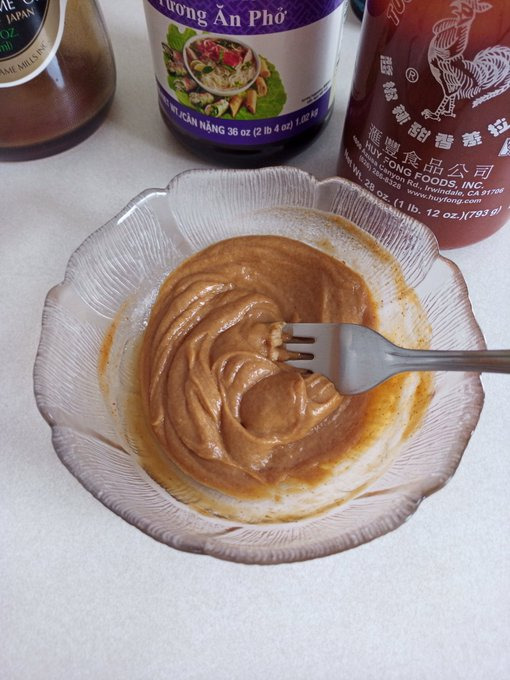
peanut sauce is just peanut butter+water, hoisin+sriracha sauce, and a tiny bit of sesame oil (tastes good with almost anything imo)
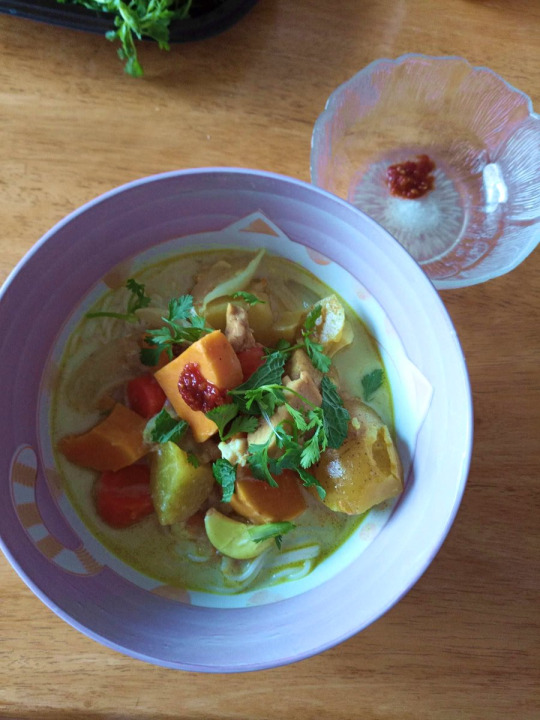
yellow curry
rice noodle with chicken, potatoes, yams, onions, carrots in a creamy coconut milk and yellow curry paste broth
lemon juice and salt mix with garlic chili for dipping

bò kho (vietnamese beef stew)
kho is a cooking technique where a protein is braised in a mixture of fish sauce, sugar, and water or coconut juice to make a salty/savory result
bread dips in stew beef/potatoes dip in lime juice/salt/pepper mix
cucumber slices to offset the salty
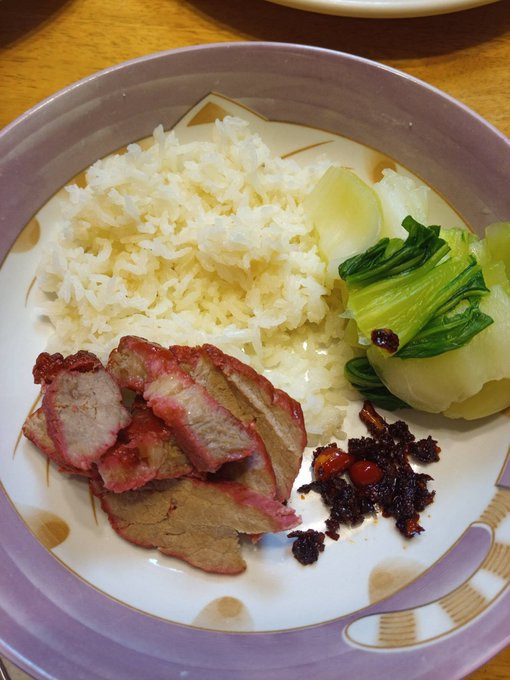
xá xíu (cantonese style bbq pork)
the seasoning mix is made of sugar, powdered soy sauce, onion and garlic powder, and spices
the pink color very much freaked out middle schoolers at lunch

cơm tấm (broken rice, grilled pork, egg, pickled carrots/daikon with scallions/oil garnish and fish sauce)
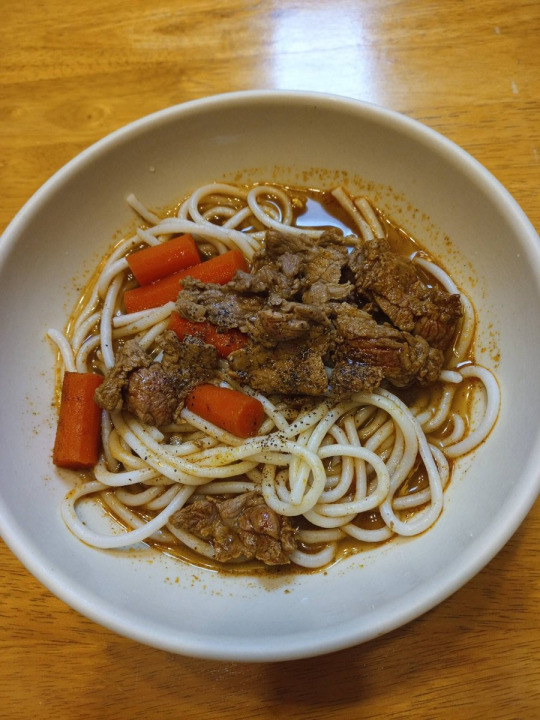
bún bò huế (thick round rice noodle with beef soup)
more "fun" than phở imo
bún bò broth: spicy salty flavor (lemongrass, spicy chili, fermented shrimp paste, fish sauce)
phở broth: earthy sweet flavor (cinnamon, star anise, onion, ginger, garlic, herbs)
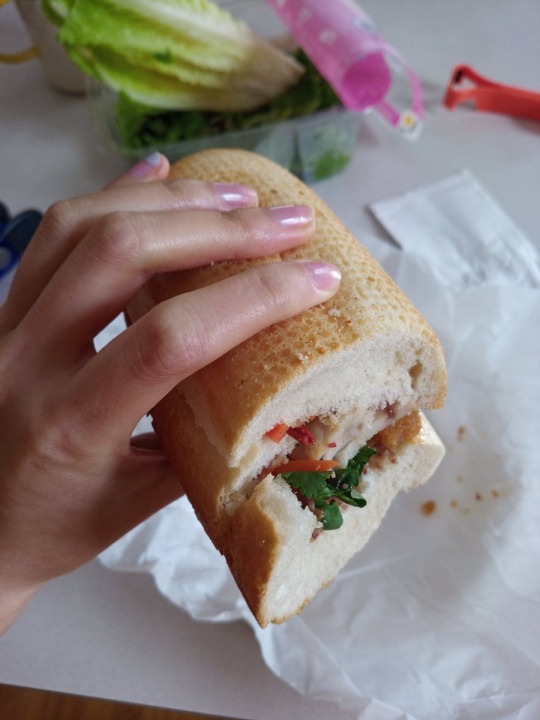
bánh mì (baguette sandwich with chả lụa (pork sausage), xá xíu (cantonese style bbq pork) coriander leaf (cilantro), cucumber, pickled carrots, and pickled daikon combined with pâté and buttery mayonnaise)

salmon instead of nem nướng̣ (viet grilled pork) with bánh hỏi (rice vermicelli)
feat nori (dried edible seaweed)
wrapped with lettuce and dipped in nước mắm (fish sauce)
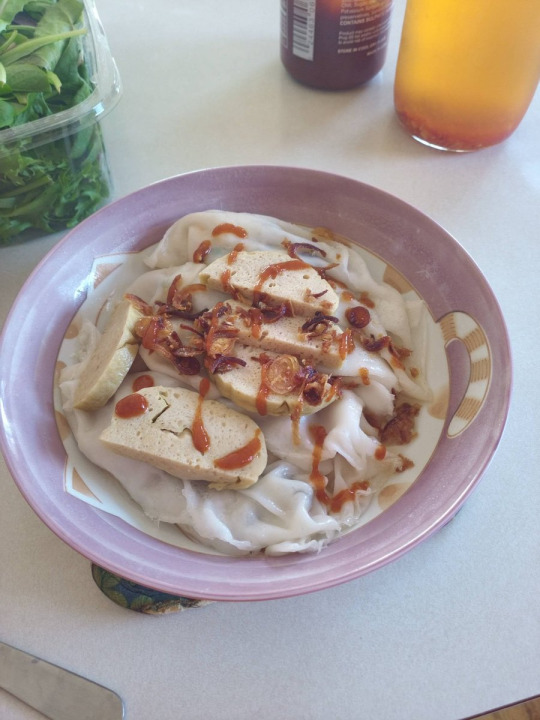
bánh cuốn (rice noodle rolls filled with ground meat, wood ear mushrooms, onions)
topped with chả lụa (pork sausage) and fried red onions and nước mắm (fermented salted fish sauce)
a fav of grandpa's
pizza man mispronounces it as "bun goo" which makes my mom giggle cause the way he says goo sounds like penis

bánh tét (glutinous rice rolled in a banana leaf into a thick, log-like cylindrical shape, with a mung bean and pork filling)
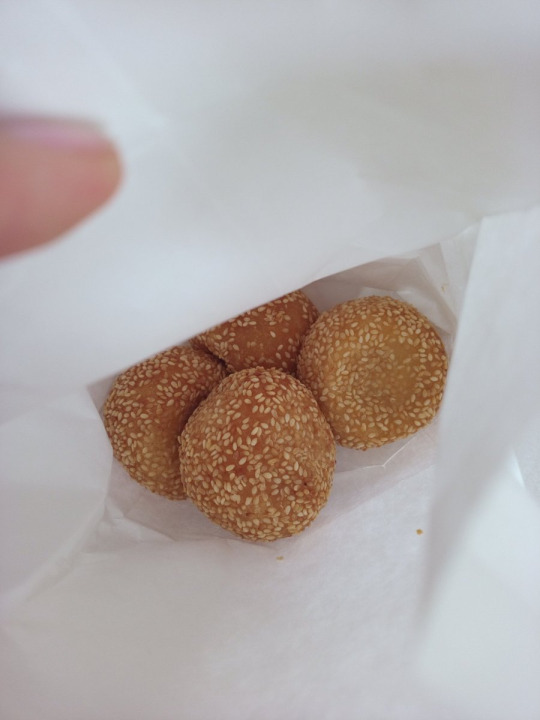
bánh rán (deep fried sesame ball filled with mung bean)
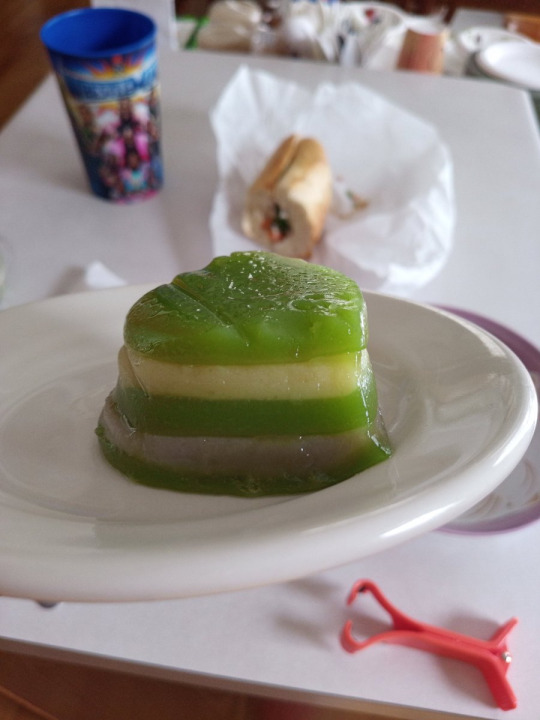
bánh da lợn "pig skin cake" (tapioca starch, rice flour, mung bean, taro, coconut milk)
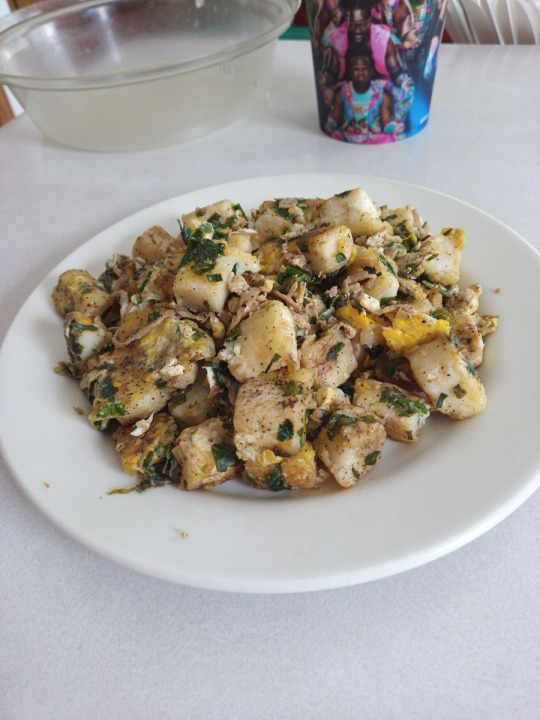
bánh bột chiên (fried taro rice cake, a fav of pizza man)

phở (broth: earthy sweet flavor- cinnamon, star anise, onion, ginger, garlic, herbs)
ive called phở mid but while eating this i was like huh this is good actually then my dad says this time he simmered chicken bones for hours like he's supposed to instead of using canned broth
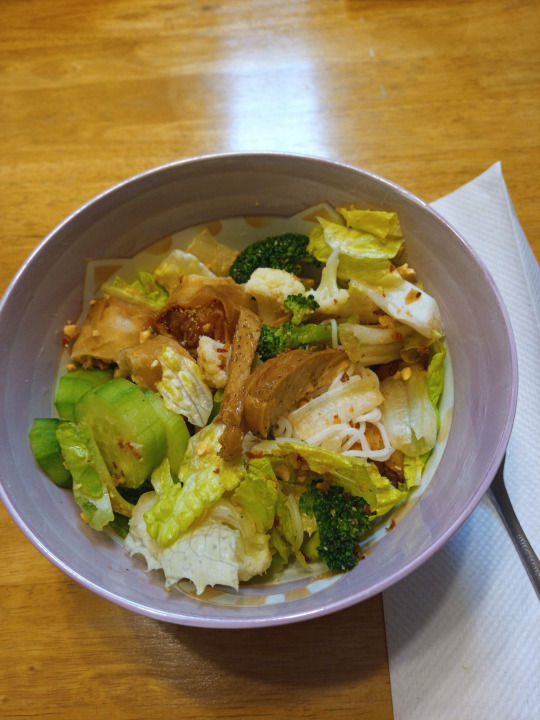
improvised bún thịt nướng (rice noodle bowl with chopped grilled pork, egg roll, veggies, crushed peanuts, fish sauce)
a way to deal with leftover noodles from gỏi cuốn
every time i eat this i think of the time me and pizza man were in new orleans and he asked if i wanted to eat at a viet place and i was surprised cause he's not really into a lot of viet food but anyway i got bún thịt nướng

thịt kho (pork with eggs braised in sticky savory caramel of sugar, fish sauce, coconut water)
i have distinct flashbacks of being in the middle school cafeteria with my thịt kho and kids around me going "what is that??", "ewwww" lol
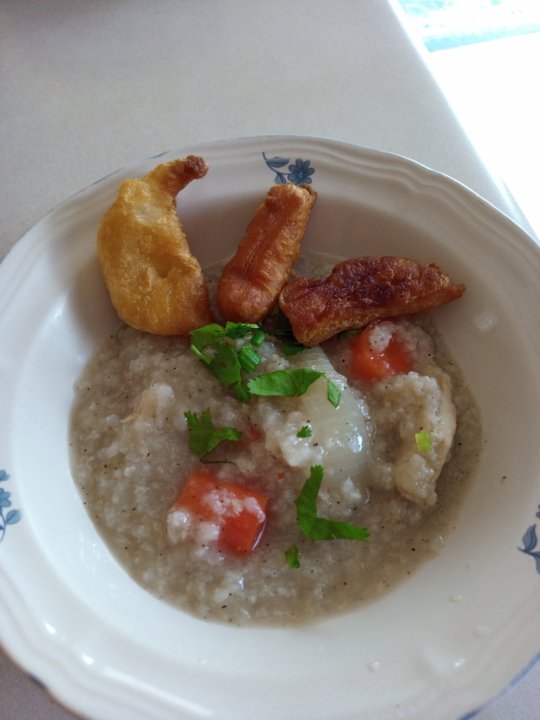
cháo (rice porridge with chicken or a white meat fish- often served with crunchy cabbage salad)
my dad likes it with youtiao (chinese donuts)
being sick means eating this! but we also eat it a lot when we’re not sick!
when my mom was young she would say yes to any dude that asked her out and order an obscene amount of food/the most expensive things on the menu and never hear from them again but my dad took her to a cháo place cause that was his favorite but apparently for cheapskates
he proposed two weeks later and she said yes
my mom is such a menace i wanna be just like her
70 notes
·
View notes
Text
Spirit Bistro deliveries
Tried more items from Spirit Bistro bcos each order met or exceeded our expectations :D We've ordered several times over the past 3 months so I decided to combined everything into 1 post.

Left: Singaporean noodles; Right: chicken + salted fish fried rice
I'll start with the noodles 1st. 9.2/10! Very tasty! Had a nice kick to it & flavour was good. I would say it was lacking in some protein (the bbq pork/cha siu pieces) but again, generous portion size.
The rice was alright; not as good as the noodles but still, I'd give it a 8.1/10. I prefer another type of salted fish - the softer/mushy ones. They used the harder shred-ier kind. I find this latter kind doesn't have as much depth as the kind that I like. Would have been better if they added more.

Over $35 gets you 2 free spring rolls. They were okay; typical spring roll (vegetarian).
The entree we got was the curry beef brisket. Not an item my family gets usually. .. but SO YUMMY!!

Mom's fav~ They have been consistant with this dish so we are very happy!
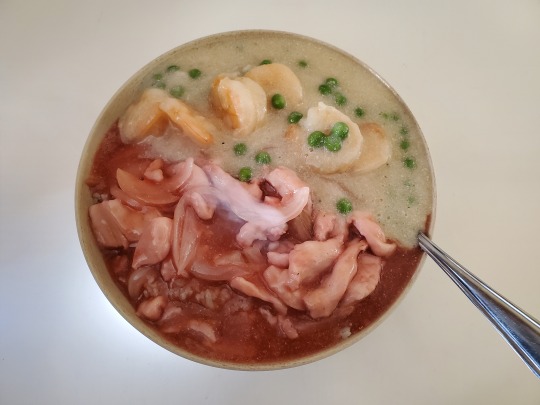
Th yin-yang rice. This 1 dish came in 3 separate containers: 1 large box for the rice, & 2 smaller containers for the 2 different topping sauces. The white 'cream' one has shrimp & green peas in a savoury egg sauce. The red one has chicken breast & onion. The colour of the red sauce was sketchy NGL. Usually it's a bright red tomato red - almost like pasta sauce. But this was like a dark sick-pink. It was weird o_O However, the red sauce one (kinda like the sauce fr sweet & sour pork) actually tasted better! haha the egg cream one was kind of bland & a little too watery.
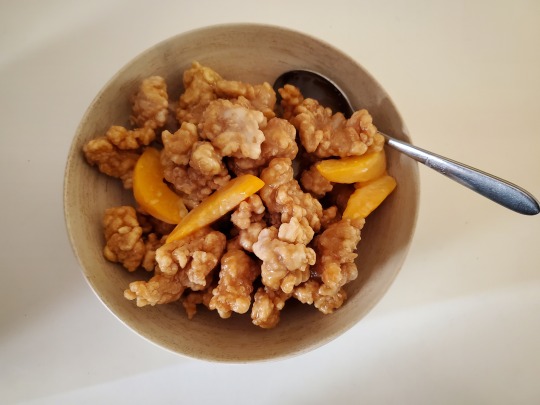
Peach & shrimp .. . nope. Peaches & chicken! I have not seen this dish on other menus before... or maybe bcos I keep eating from the same Chinese restaurants lol but yeah, a variation of the classic peaches & shrimp. The chicken was decent but there wasn't much chicken in it, mostly batter. But if you're craving some crunch, I would recommend. The sauce was also good. I don't like having the sauce all mixed in with the fried items usually so when I re-assembled this dish, I only poured a little bit of sauce on top for a slight glaze. The rest of the sauce was left in the small sauce container for dipping (team dip right here *arm up*)
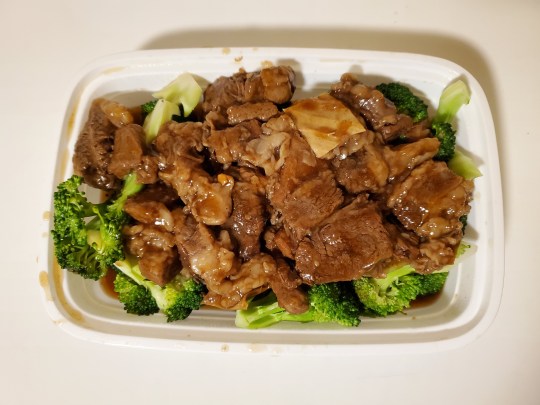
Braised beef brisket. WOW! It may seem there's not much meat / you may assume it's a whole layer of broccoli on the bottom; however, the portion was very generous, so there was actually a lot of beef! Some pieces were fully fat, which I don't eat so I did toss out some pieces. But otherwise, there was a lot. Very well cooked - the brisket was soft & very flavourful. It wasn't too salty & the sauce was very good on rice, even though I'm not a rice person. & broccoli was broccoli haha

The Spirit Rice Noodles. Honestly did not know what to expect for their house fried noodle dish but this was what we got. Thin rice vermicelli noodles with onion, bean sprouts, scant pieces of celery, cha-siu (Cantonese-style bbq pork), baby shrimps, & small pieces of pork. It was slightly spicy & had a good amount of wok-smokiness. It was decent!
**PS: I'm working hard on posts, I swear! My laptop is dying. .. it is so slow. I tried editing on my phone but once in a while, the app crashes & what I wrote didn't save so it is useless. SAWRY
3 notes
·
View notes
Text
Beef Pares Mami
Tender braised beef, savoury broth, and mami noodles make up this comforting Filipino fusion of Beef Pares and Mami soup. This bowl is the perfect blend of sweet, savoury, and comforting—just what I need on a cold day! #BeefParesMami If there’s one dish that warms my soul on any given day, it’s Beef Pares Mami. Combining my love for soups and beef, this dish takes the best of both worlds and…
0 notes
Text
What Koreans eat during Chuseok, | japchae, yukjeon, songpyeon, dong geulangttaeng
*Picture source: Recipes of 10,000, KOREA BAPSANG

Chuseok, also call ed Hangawi, is an event held on the 15th day of the lunar calendar, and it is Korea's major and national holiday, along with Lunar New Year. This year, 2024 will have a five-day holiday period, including the weekend from Monday, Sept. 16 to Wednesday, Sept. 18.
It is similar to Thanksgiving Day in the United States. The two expressed their gratitude for allowing them to harvest food safely throughout the year based on farming, but their food, play, and culture are different.
Then, what do Koreans eat during Chuseok? It varies from region to region, but songpyeon is usually the iconic Chuseok food. To top it off, there are donggrang dang, assorted jeon, braised short ribs, herbs, radish soup, and japchae. Let me explain each dish right away.
1. Songpyeon

Songpyeon is a traditional Korean rice cake that is absolutely eaten during Chuseok. Songpyeon is made by adding beans, sesame seeds, or red beans to sticky rice dough, forming a half-moon shape and steaming it on pine needles. It is very delicious because the rice cake is chewy and has a sweet or savory inside. Celebrating Chuseok with your family while eating songpyeon is one of the important traditions in Korea.
2. Japchae
Japchae is Korea's representative noodle dish made with glass noodles. The glass noodles are chewy with sweet potato starch, and we stir-fry various vegetables and meat together. It is seasoned with soy sauce and has a sweet and salty taste, making it a favorite food. It is a popular dish that does not leave out japchae during Chuseok.
3. Galbijjim

Braised short ribs is a dish made by gently boiling beef ribs or pork ribs. Because the meat has been cooked with various ingredients such as soy sauce, garlic, and jujube for a long time, the texture that melts in your mouth is superb. With its sweet and salty combination, it is one of the must-eat foods during the Chuseok holiday.
4. Modeumjeon (+dong geulangttaeng)

A assorted pancake is a type of pancake that is coated with various ingredients in egg water and steamed in oil. One of the best examples is a meat and vegetables. It is crispy on the outside and moist on the inside. In Korea, when you eat jeon, it is common to dip it in soy sauce, so it is delicious with its flavor.
5. Muguk

Radish soup is a clear and light soup, and its main ingredients are radishes and meat. Radish is soft and sweet, so the soup is cool and light. After eating a lot of greasy food during the Chuseok holiday, it's perfect for a light soup to cleanse your mouth. It's a simple and warm soothing dish.
6. Yukjeon

Meat pancake is a dish made by coating thinly sliced beef with egg water. The meat is soft and the savory taste of the egg melts gently in the mouth. Meat pancake is more delicious when dipped in sauce or eaten with other foods, and is one of the dishes you don't miss during the Chuseok holiday.
7. Namul

Vegetables are a traditional Korean side dish made by boiling or roasting various vegetables. Each vegetable is seasoned with sesame oil and salt to give it a soft and savory taste. On Chuseok, it is a meaning to eat various vegetables together and pray for good health. It is a simple yet nutritious side dish, so I would like to recommend it to foreigners as well.
What kind of Chuseok food do you want to try?
It's Chuseok holiday in Korea soon, so I hope you have a great holiday if you have Thanksgiving
0 notes
Text
Craving Alert! 7 Restaurants in LA Stealing the Spotlight
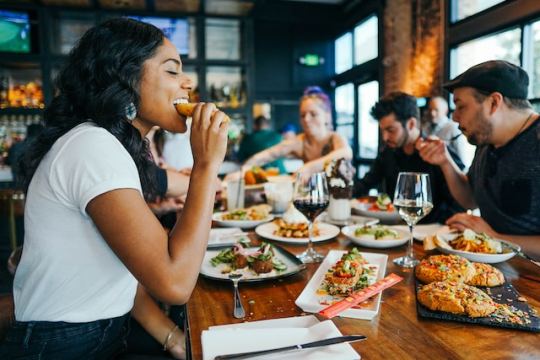
Forget your boring, same-old dinner routine! Los Angeles is serving up a sizzling summer with a fresh crop of incredible new restaurants. From Persian soul food to Michelin-starred pizza artistry, this list is your ultimate guide to the hottest dining experiences in the City of Angels. Whether you're a budget-conscious gourmand or a special occasion foodie, we've got your cravings covered. Dive in and discover your next LA culinary adventure! 1. Azizam Where> 2943 W Sunset Blvd, Los Angeles Embark on a culinary journey to Persia at Azizam. This inviting eatery showcases homestyle delights like succulent turmeric-braised chicken and decadent kofte tabrizi, a giant beef meatball bursting with a delightful surprise of walnuts and dried fruits. The emphasis on fresh, high-quality ingredients and a charming atmosphere make Azizam a perfect choice for a casual yet memorable meal. 2. Stella in Beverly Hills Where> 8899 Beverly Blvd, West Hollywood For those seeking an exquisite fine-dining experience, Stella presents a modern interpretation of Italian cuisine. Chef Rob Gentile's masterful touch is evident in every dish, from the luxurious burrata adorned with Canadian olive oil and caviar (optional) to the tableside preparation of branzino crudo. Stella promises an unforgettable exploration of Cal-Italian flavors in a sophisticated, subterranean setting. 3. KTeam BBQ in Koreatown Where> 936 S Vermont Ave, Los Angeles Immerse yourself in the vibrant Koreatown barbecue scene at KTeam BBQ. This newcomer offers a more affordable approach to Korean barbecue, without compromising on quality. Savor the melt-in-your-mouth thinly sliced frozen pork belly, their signature offering, or savor the classic tteokbokki alongside an array of delectable banchan side dishes. KTeam BBQ promises an authentic taste of Seoul at an accessible price point. 4. Bread Head in Santa Monica Where> 1518 Montana Ave, Santa Monica The highly anticipated Bread Head has finally arrived, gracing Santa Monica with its artisanal take on the humble sandwich. Expect an explosion of flavor with every bite, thanks to their signature, impossibly crackly focaccia bread. Bread Head elevates the sandwich experience with top-notch meats, gourmet cheeses, and inventive flavor combinations. 5. Burgette in Santa Monica Where> 111 Santa Monica Blvd, Santa Monica Channel your inner Parisian at Burgette, a Santa Monica gem specializing in gourmet takes on the classic burger. Their menu boasts a variety of unique options, including pescatarian and vegetarian choices. However, the showstopper is undoubtedly the La Vivienne burger, a decadent masterpiece featuring bone marrow butter, melted raclette cheese, and a touch of sweetness with tomato jam. Don't forget to indulge in their perfectly crisped French fries for a truly satisfying dining experience. 6. Kitakata Ramen Ban Nai Where> 4338 Pacific Coast Hwy, Torrance The beloved Kitakata Ramen chain has finally landed in the South Bay, bringing their acclaimed ramen expertise to Torrance. Step away from the usual tonkotsu broth and delve into their signature shoyu ramen, a clear and flavorful pork broth paired with perfectly cooked shina soba noodles. Craving a spicier option? The green chili shio ramen with its scallion garnish provides a welcome kick. Kitakata Ramen Ban Nai offers a delightful selection of gyoza and other sides, catering to all palates. 7. Leopardo Where> 460 S La Brea Ave, Los Angeles Michelin-starred Chef Joshua Skenes takes center stage at Leopardo, his new venture in La Brea. This "casual" pizzeria, where quotation marks feel entirely appropriate considering the multi-course tasting menu option, elevates pizza to an art form. Black-spotted, crust-dominant pies showcase the quality of seasonal ingredients, while unique toppings like housemade giardiniera and stracciatella cheese add unexpected layers of flavor. Leopardo offers a truly multifaceted dining experience, with delectable raw dishes, wood-fired mains, and a stellar dessert selection. While the price point reflects the exceptional quality, the pizza remains the undeniable star, offering a luxurious yet approachable introduction to Leopardo's culinary artistry. For more updates on eat & drink check out WhatsOn 1. Azizam 2. Stella in Beverly Hills 3. KTeam BBQ in Koreatown 4. Bread Head in Santa Monica 5. Burgette in Santa Monica 6. Kitakata Ramen Ban Nai 7. Leopardo Read the full article
0 notes
Text
Haven’t patronize LeNu Chef Wai’s Noodle Bar (樂牛私房面家) at Northpoint City for a while so we are here for an early dinner. Placed an order for our noodles and also adds S$3.50++ for the Apple Black Tea and Silken Tofu with Century Egg (皮蛋豆腐) appetizer. The tofu is served with a thick savoury sauce and topped with bonito flakes and scallions.
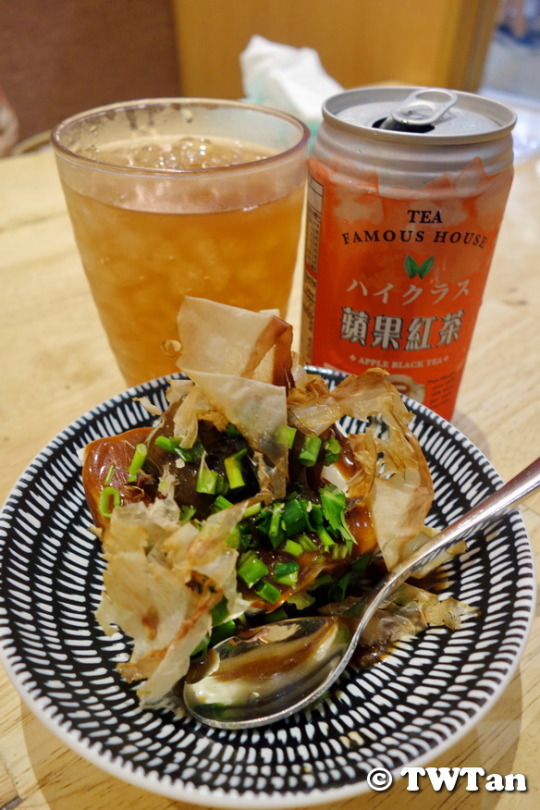
My Braised Beef Combination Noodle (红烧牛三宝面) (S$16.50++) came with wagyu beef, tendon and shank meat with pickled sour vegetable. I opted for ramen noodles to soak up the flavourful and wholesome dark brown broth. Both types of meats are braised till tender and soft while the tendon still retained that springy texture.


Mum had her usual Braised Beef Tendon Dry Noodle (红烧牛筋干捞面) (S$11.90++) but with ramen noodles instead of thick rice vermicelli. Beside the springy tendons, the dry style noodles came sprinkled with crispy sesame seeds crusted anchovies and crunchy peanuts on strips of cucumber and seaweed.

#LeNu Chef Wai’s Noodle Bar#樂牛私房面家#Northpoint City#Taiwanese#Tofu#Century Egg#皮蛋豆腐#Apple Black Tea#Braised Beef Tendon Dry Noodle#红烧牛筋干捞面#Ramen#Noodles#Bonito Flake#Scallions#Spring Onion#Braised Beef Combination Noodle#红烧牛三宝面#Wagyu Beef#Tendon#Beef Shank#Pickled Vegetable#Anchovies#Ikan Bilis#Peanut#Broth#Soup#Food#Buffetlicious
21 notes
·
View notes
Text
Father's Day Celebration at Marco Polo Ortigas Manila
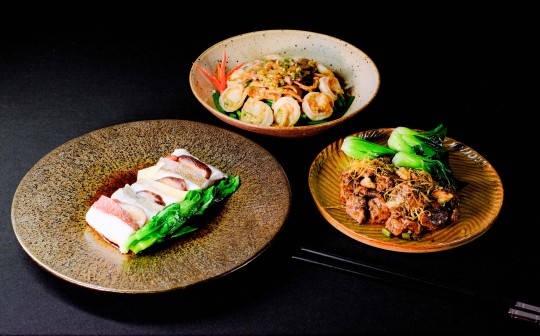
A wonderful time awaits families in Marco Polo Ortigas Manila this June, as the hotel celebrates fathers of all kinds with exciting experiences, bespoke dining and memorable stays. Renowned Cantonese restaurant Lung Hin put together its best dishes for the man of the hour. From June 06 to 16, the entire family will surely appreciate a generous 10-course meal prepared to authentic perfection, starting with Lung Hin’s Signature Crispy Suckling Pig, premium Bird’s Nest Peach Gel soup and Seafood, Pan-Fried U.S.Beef Tenderloin cubes, flavourful Wok-Fried Shrimp and Sea Conch Garden Green, Braised Japan Shiitake and Spiked Sea Cucumber in Abalone sauce, Hong Kong style Steamed Sea Grouper Fillet, Deep Fried Trio Crispy Pigeon, with a choice of Fried Red Rice and Roasted Pork Belly or Braised Fresh Egg Noodle Wanton and Barbecue Pork, and a tasty finish of Baked Macau Egg Tart and Seasonal Fresh Fruit Platter.
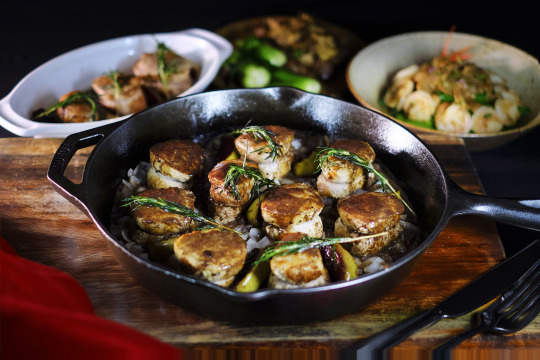
Bring a smile to Dad’s face when you take him out to lunch or dinner buffet at Cucina. The highlights of Marinated Smoked Beef Short Ribs, Pan-Seared Pork Medallon, Heineken Beer-Battered Red Drum Fish Fillet and Chicken Piccata Fillet in Brown Butter, Roma Tomato Jalapeno Salsa, together with delightful starters and salads, freshly baked bread, seafood on ice, whets the appetite. The bestselling stations of Japanese sushi and sashimi, noodles, and an array of desserts will surely thrill and satisfy cravings. Make it even more fun for him with a complimentary meal, when accompanied by four full-paying adults. The children may join the sumptuous feast free of charge, for those aged seven years and below.

Dads will definitely love the bittersweet notes of Gianduja Chocolate, paired with a cappuccino crème brulee in one charming cake! Café Pronto designed a smooth and balanced confectionary treat just for him. From June 06 to 16, gift your main man with a 6-inch cake for Php 1,850 nett.
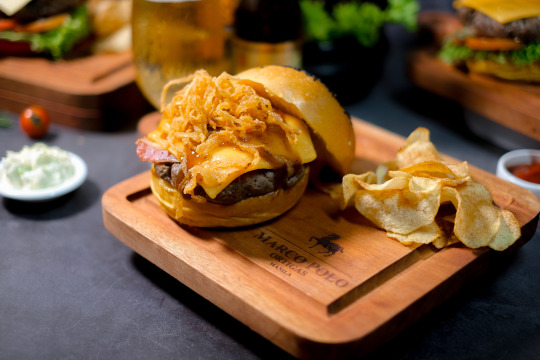
Connect Lounge’s mouthwatering, tender burgers are all Dad’s, at 20% off. Dine from June 06 to 16 as a group of three with him, and savor your own BLT Cheeseburger, Blue Cheese Mushroom Burger, Pull Pork BBQ Burger, Texas Beef Burger and All Day Breakfast Burger at a discounted price, for a maximum of two burgers per receipt.
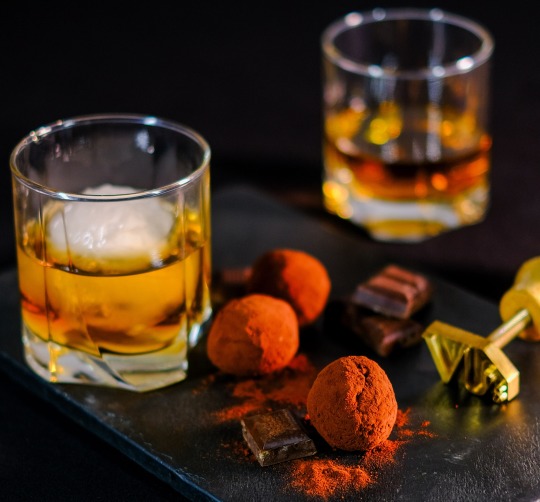
Vu’s Sky Bar and Lounge crafted a sophisticated duo for men with exceptional taste. From June 06 to 16, sample a great combination of the strong and the mild with Whiskey and Chocolate Truffle pairing to toast Dad for his awesome! Pairing starts at Php 490++. Give Dad a restful weekend at Marco Polo Ortigas Manila, focusing on everything good for the body and spirit when availing the Weekend Retreat Room package. Stay on a weekend and have him relax in an upgraded room to unwind in for longer, with a guaranteed late checkout. The day starts off with a thoughtful healthy welcome gift, followed by a one-on-one, 35-minute tabata or high intensity interval training (HIIT). Should a spa day be in order, avail all services at 20% off its regular rate, while enjoying all the hotel amenities, including an indoor temperature-controlled swimming pool, jacuzzi and sauna. For maximum enjoyment, a Php 1,500 dining credit can be used in Cucina, Lung Hin, Café Pronto or dining from the comfort of the room. Finally, let him have a wonderful buffet breakfast for two at Cucina, to start his day right.
For room reservations, please call (+63 2) 7720 7777. To #ExploreDiscoverExperience more about what the hotel has to offer, follow Marco Polo Ortigas Manila on Facebook, Instagram and LinkedIn.
0 notes
Text
youtube
Exploring the World of Beef: A Culinary Journey Through Famous Dishes
Beef, a versatile and richly flavored meat, holds a prominent place in cuisines around the world. Its adaptability in various cooking methods—from grilling and roasting to stewing and braising—has given rise to a plethora of famous dishes. Join us as we embark on a culinary journey through some of the most celebrated beef dishes from different cultures.
1. Steak: The Quintessential Beef Dish
When it comes to beef, steak is arguably the most iconic preparation. Whether you prefer a juicy ribeye, a tender filet mignon, or a flavorful sirloin, steak embodies the essence of beef's natural flavors. Cooked to perfection on a grill or in a cast-iron skillet, and often seasoned with just salt and pepper, steak is a testament to the idea that simplicity can be the ultimate sophistication.
2. Beef Bourguignon: A French Classic
Beef Bourguignon, a traditional French dish, elevates beef to new heights. This slow-cooked stew, originating from the Burgundy region, features beef braised in red wine along with carrots, onions, garlic, and a bouquet garni. The addition of mushrooms and pearl onions towards the end of cooking adds depth and texture. Served with mashed potatoes or crusty bread, Beef Bourguignon is the epitome of French comfort food.
3. Tacos de Carne Asada: Mexican Street Food Delight
Mexico's vibrant culinary scene boasts numerous beef dishes, but Tacos de Carne Asada stand out for their simplicity and flavor. Carne Asada, meaning "grilled meat," involves marinating beef (typically flank or skirt steak) in a mix of citrus juices, garlic, and spices before grilling. Served on soft corn tortillas and topped with fresh cilantro, onions, and a squeeze of lime, these tacos are a beloved street food favorite.
4. Beef Wellington: An English Masterpiece
For those seeking a show-stopping dish, Beef Wellington is an excellent choice. This English classic consists of a tender beef fillet coated with a layer of pâté and duxelles (a finely chopped mixture of mushrooms, onions, and herbs), all wrapped in puff pastry and baked until golden brown. The result is a succulent and visually stunning centerpiece, often reserved for special occasions.
5. Pho Bo: Vietnamese Comfort in a Bowl
Pho Bo, or Vietnamese beef noodle soup, is a dish that warms the soul. This aromatic soup features thinly sliced beef served in a clear, fragrant broth made from simmering beef bones, star anise, cinnamon, and other spices for hours. Accompanied by rice noodles, fresh herbs, bean sprouts, and lime wedges, Pho Bo is a comforting and nourishing meal enjoyed at any time of day.
6. Bulgogi: Korean BBQ Excellence
Bulgogi, which translates to "fire meat," is a popular Korean dish made from thinly sliced beef marinated in a mixture of soy sauce, sugar, sesame oil, garlic, and pepper, then grilled or stir-fried. The marinade imparts a sweet and savory flavor, making Bulgogi a delightful experience whether served with rice, in lettuce wraps, or as part of a Korean BBQ spread.
7. Beef Stroganoff: Russian Indulgence
Beef Stroganoff, a Russian culinary gem, combines tender strips of beef with a creamy sauce made from sour cream, onions, and mushrooms. This dish, typically served over egg noodles or rice, offers a rich and satisfying flavor profile. Its origins date back to the 19th century, and it has since become a beloved comfort food around the world.
8. Churrasco: South American Grilling Tradition
Churrasco, a term broadly used in South America, especially in Brazil and Argentina, refers to beef grilled over an open flame. In Brazil, it often involves large cuts of beef, such as picanha (top sirloin cap), seasoned simply with coarse salt and cooked on skewers. Served with chimichurri sauce and accompanied by sides like farofa (toasted cassava flour) and grilled vegetables, Churrasco is a celebration of bold, natural flavors.
9. Corned Beef and Cabbage: An Irish-American Staple
While not originally from Ireland, Corned Beef and Cabbage has become a staple in Irish-American cuisine. This dish features beef brisket cured in a brine of salt, sugar, and spices, then simmered until tender and served with cabbage, potatoes, and carrots. Traditionally enjoyed on St. Patrick's Day, Corned Beef and Cabbage has become synonymous with Irish-American heritage.
10. Sukiyaki: Japanese Hot Pot Harmony
Sukiyaki is a beloved Japanese hot pot dish where thin slices of beef are cooked in a shallow iron pot with a sweet-savory broth made from soy sauce, sugar, and mirin. Accompanied by tofu, vegetables, and noodles, Sukiyaki is often enjoyed communally, with diners dipping the cooked beef and vegetables into raw, beaten egg before eating, creating a rich and creamy texture.
Beef's rich flavor and versatility make it a cornerstone in many of the world's most beloved dishes. From the elegance of Beef Wellington to the comforting warmth of Pho Bo, each dish highlights unique culinary traditions and techniques. Exploring these dishes not only satisfies the palate but also offers a delicious journey through diverse cultures and histories. So next time you're planning a meal, consider taking a culinary trip around the world with one of these iconic beef dishes.
0 notes
Text
Classic Food Recipes: Timeless Flavors That Delight
Beef Bourguignon
Originating from the Burgundy region of France, Beef Bourguignon is a quintessential classic dish. This hearty stew combines tender beef braised in red wine with an assortment of vegetables, creating a rich and flavorful meal. The key to a perfect Beef Bourguignon lies in slow cooking, allowing the flavors to meld together beautifully. Traditionally, this dish is served with creamy mashed potatoes or crusty French bread, making it a comforting choice for cold evenings.
Chicken Parmesan
Chicken Parmesan, or Chicken Parmigiana, Healthy Meal Prep Ideas is an Italian-American classic that has won the hearts of many. Breaded chicken cutlets are fried until golden and crispy, then smothered in marinara sauce and melted mozzarella cheese. Often served with spaghetti or as a sandwich filling, Chicken Parmesan is a versatile and crowd-pleasing dish. The combination of savory chicken, tangy tomato sauce, and gooey cheese creates a mouthwatering experience that is hard to resist.
Coq au Vin
Another French classic, Coq au Vin, translates to "rooster in wine." This rustic dish features chicken slow-cooked with red wine, mushrooms, onions, and bacon. The result is a tender and flavorful meat that falls off the bone, enriched with a deep, savory sauce. Coq au Vin is traditionally served with potatoes or buttered noodles, making it a perfect dish for special occasions or Sunday dinners.

Ratatouille
Ratatouille is a vibrant vegetable medley from the Provence region of France. This dish highlights the flavors of summer with ingredients like eggplant, zucchini, bell peppers, and tomatoes. Each vegetable is sautéed individually to maintain its distinct flavor and texture before being combined and simmered to perfection. Ratatouille can be served as a main dish, a side, or even a topping for crusty bread. Its colorful presentation and healthy ingredients make it a favorite among vegetarians and vegans.
Tiramisu
Tiramisu, meaning "pick me up" in Italian, is a classic dessert that has become synonymous with indulgence. This layered dessert consists of coffee-soaked ladyfingers, rich mascarpone cheese, cocoa powder, and sometimes a splash of liqueur. The combination of coffee and creamy cheese creates a delectable contrast, while the cocoa powder adds a touch of bitterness. Tiramisu is best enjoyed chilled, allowing the flavors to meld and the layers to set, resulting in a perfect end to any meal.
Apple Pie
No list of classic food recipes would be complete without mentioning Apple Pie, an iconic American dessert. This timeless treat features a flaky pastry crust filled with sweet, spiced apples. The key to a great Apple Pie is using a mix of tart and sweet apples, such as Granny Smith and Honeycrisp, to create a balanced filling. Often served with a scoop of vanilla ice cream, Apple Pie is a comforting dessert that embodies the spirit of home and tradition.
0 notes
Text
FMP
Dai Pai Dongs - who's still standing?
Through a lot of secondary research, I found that there are only 15 remaining authentic Dai Pai Dongs that are still open in 2024. They are scattered around Hong Kong, but each offer their own story, specialties and unique locations.
Bing Kee Cha Dong
One of the last remaining old school Hong Kong cafes
based in Tai Hang
breakfast and lunchtime spot
typical dishes include noodle soup, noodles with egg, french toast and milk tea
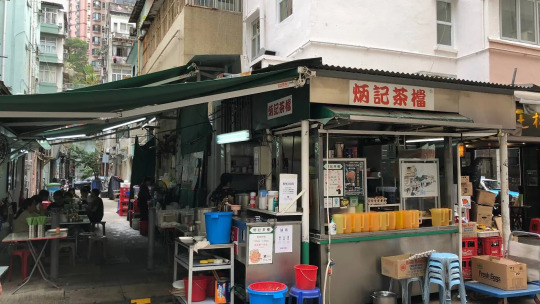
2. Sing Kee
outdoor restaurant in an alleyway
survived the government moving dai pai dongs around in the 1970s
morning till night time service
popular foods include salt and pepper squid and sweet and sour pork

3. Keung Kee
based in Sham Shui Po
only has 6 tables
near Apliu market
tables face the kitchen so you can see the chefs cooking
known for Hainan chicken and seafood dishes

4. Sing Heung Yuen
Mee Lun street, Central
mix of office workers and labourers
popular at lunch time
comfort food such as tomato and scrambled eggs, lemon honey on toast
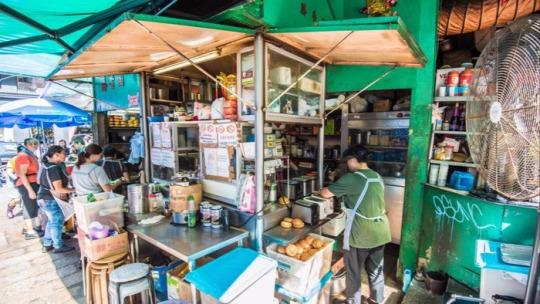
5. Ball Kee
Staveley Street, Central
Busy at lunch time
noodles, rice, meat, veg and soy sauce combinations
local business men are the usual clientel at lunch time

6. So Kee
known for their Yuen Yeung - milk tea and coffee
more of a cafe/noodle shop
popular dishes include french toast and pork ramen
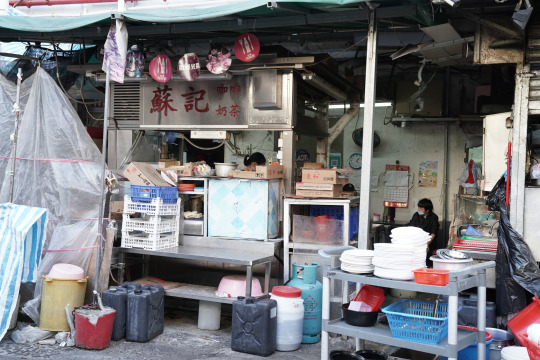
7. Yuk Yip Dessert
Elgin Street, Central
popular dishes include Black Sesame soup and mango sago
popular for late night meals after dinner
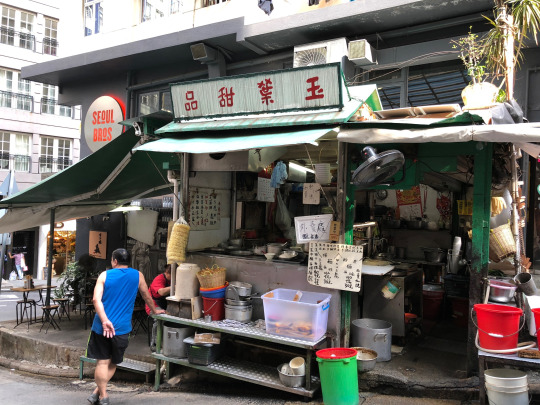
8. Dai Lee Dai Pai Dong
Pei Ho Street Market, Sham Shui Po
operating for 50 years
known for their minced pork and braised fish

9. Woosung Street Cooked Food
in Jordan
opened in 1984
cha chaan teng food by day and stir fry by night
lively atmosphere

10. Oi Man Sang
operating in Sham Shui Po since 1956
oldest dai pai dong in Hong Kong
menu has barely changed since it first opened

11. Chui Wo Lee
Wong Tai Sin Street Restaurant
one of the few remaining housing estate cooked food stalls in Hong Kong
operated by 3 owners
open 24 hours a day
dim sum, cheung fun, congee etc.
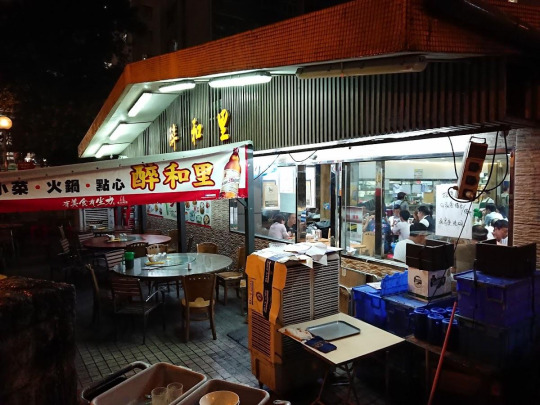
12. Tai Yuen Dai Pai Dong
In Fo Tan
open 4:30-1:30am
known for roast pigeon and salt and pepper tofu

13. Hong Kee Restaurant
in Kowloon Bay
open 5pm-2am
known for their garlic prawns and Bombay duck
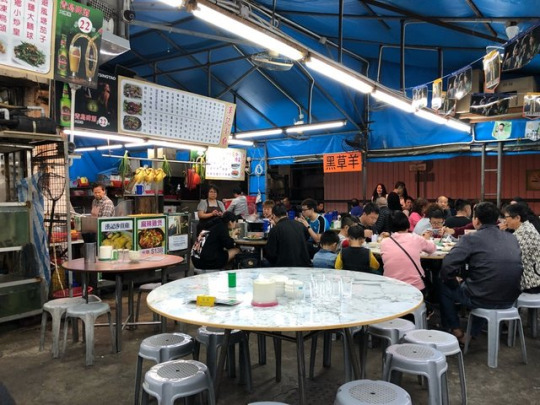
14. Yuk Kin Fast Food
Long standing Dai Pai Dong
Tai Ping Street, Sai Ying Pun
popular dishes include sliced beef, shrimp egg and rice

15. Temple Spice Crabs
known for their seafood dishes - spicy crab and shrimp
based in yau ma tei
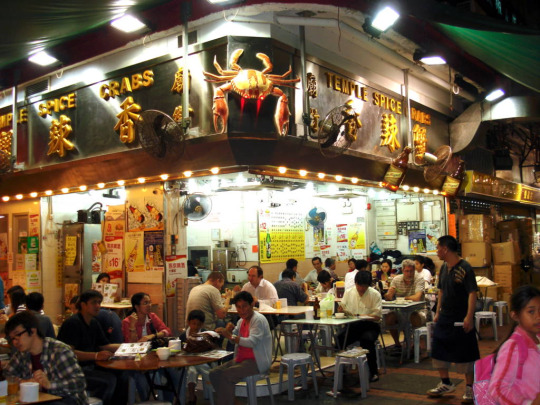
Asia, T. (2023). Hong Kee. [online] Tatler Asia. Available at: https://www.tatlerasia.com/dining/hong-kee-restaurant-hong-kong [Accessed 3 Mar. 2024].
Asia, T. (2023). Tai Yuen Dai Pai Dong. [online] Tatler Asia. Available at: https://www.tatlerasia.com/dining/tai-yuen-dai-pai-dong-hong-kong [Accessed 3 Mar. 2024].
Chiu, A. and Leung, J. (2024). 12 Best dai pai dongs you need to try in Hong Kong. [online] Time Out Hong Kong. Available at: https://www.timeout.com/hong-kong/restaurants/best-dai-pai-dong-hong-kong [Accessed 1 Mar. 2024].
Discover Hong Kong. (2023). Sing Heung Yuen | Hong Kong Tourism Board. [online] Available at: https://www.discoverhongkong.com/uk/interactive-map/sing-heung-yuen.html [Accessed 1 Mar. 2024].
Discover Hong Kong. (2023). Sing Kee | Hong Kong Tourism Board. [online] Available at: https://www.discoverhongkong.com/uk/interactive-map/sing-kee.html [Accessed 29 Feb. 2024].
Facebook.com. (2023). Facebook. [online] Available at: https://www.facebook.com/HongKongDaiPaiDong [Accessed 1 Mar. 2024].
Marie, C. (2024). Best dai pai dongs in Hong Kong: Good food, great buzz, and old-school vibes. [online] Honeycombers Hong Kong. Available at: https://thehoneycombers.com/hong-kong/best-dai-pai-dongs-hong-kong/ [Accessed 3 Mar. 2024].
Time Out Hong Kong. (2023). Ball Kee (波記) | Restaurants in Central, Hong Kong. [online] Available at: https://www.timeout.com/hong-kong/restaurants/ball-kee [Accessed 1 Mar. 2024].
Time Out Hong Kong. (2023). Bing Kee Cha Dong (炳記茶檔) | Restaurants in Tai Hang, Hong Kong. [online] Available at: https://www.timeout.com/hong-kong/restaurants/bing-kee-cha-dong [Accessed 29 Feb. 2024].
Time Out Hong Kong. (2018). Keung Kee (强記) | Restaurants in Sham Shui Po, Hong Kong. [online] Available at: https://www.timeout.com/hong-kong/restaurants/keung-kee-1 [Accessed 29 Feb. 2024].
Time Out Hong Kong. (2022). Yuk Kin Fast Food. [online] Available at: https://www.timeout.com/hong-kong/restaurants/yuk-kin-fast-food [Accessed 3 Mar. 2024].
Time Out Hong Kong. (2023). So Kee (蘇記茶檔) | Restaurants in Sham Shui Po, Hong Kong. [online] Available at: https://www.timeout.com/hong-kong/restaurants/so-kee [Accessed 1 Mar. 2024].
Time Out Hong Kong. (2023). Yuk Yip Dessert (玉葉甜品) | Restaurants in Central, Hong Kong. [online] Available at: https://www.timeout.com/hong-kong/restaurants/yuk-yip-dessert [Accessed 1 Mar. 2024].
Yu, H. (2021). 11 best dai pai dongs in Hong Kong. [online] Tatler Asia. Available at: https://www.tatlerasia.com/dining/food/best-dai-pai-dongs-hong-kong [Accessed 1 Mar. 2024].
0 notes
Text
Beef Pho: Exploring the Essence of Savory Steaming Bowls

Indulge in the rich and aromatic world of Beef Pho, a Vietnamese culinary masterpiece that has captured the hearts and taste buds of food enthusiasts around the globe. Steaming bowls of this iconic dish have become synonymous with comfort, authenticity, and a tantalizing symphony of flavors. Beef Pho, also known as Phở bò, is a beloved Vietnamese soup that embodies the essence of Vietnamese cuisine. This iconic dish consists of a delicate and flavorful beef broth, accompanied by tender slices of beef, silky rice noodles, and a harmonious blend of herbs and spices. With its origins rooted in the bustling streets of Vietnam, Beef Pho has transcended cultural boundaries to become a globally recognized and cherished dish. More Delicious Recipes You Will Love: - Delicious Harmony: Exploring the Flavors of Bún Chả - Thịt Kho Tàu: A Taste of Vietnamese Caramelized Braised Pork - Fresh and Flavorful Vietnamese Shrimp Spring Rolls: A Delicious and Healthy Appetizer The magic of Beef Pho lies in its simplicity and complexity all at once. Each spoonful unveils layers of umami-rich broth, carefully simmered for hours, extracting the essence from a combination of beef bones, aromatic spices like star anise, cloves, and cinnamon, as well as the delicate sweetness of onions and ginger. This hearty base sets the stage for thinly sliced beef, which cooks gently in the steaming broth, resulting in tender, melt-in-your-mouth perfection. The noodles, an essential component of Beef Pho, are typically made from rice and provide a soft and chewy texture that complements the broth. Fragrant herbs, such as fresh Thai basil, cilantro, and bean sprouts, are generously added to enhance the dish's vibrant flavors, while a squeeze of lime and a drizzle of hoisin or Sriracha sauce add a touch of tanginess and heat, allowing each diner to personalize their culinary experience. Whether enjoyed as a comforting breakfast, a satisfying lunch, or a fulfilling dinner, Beef Pho has become a staple dish that brings people together. Its versatility allows for endless variations, from regional adaptations within Vietnam to creative reinterpretations in international kitchens. No matter the setting, Beef Pho promises an immersive sensory experience that warms the soul and delights the palate. Join us as we embark on a journey through the aromatic alleys of Beef Pho, exploring its origins, savoring its flavors, and uncovering the secrets that make it a timeless culinary gem. Prepare to be captivated by the allure of this iconic dish and discover why Beef Pho has earned its rightful place as a beloved treasure in Vietnamese gastronomy. FAQ: 1. What is Beef Pho? Beef Pho, also known as Phở bò, is a traditional Vietnamese soup dish consisting of a flavorful beef broth, thin slices of beef, rice noodles, and an array of aromatic herbs and spices. 2. How is the beef broth made? The beef broth is made by simmering beef bones, such as marrow and knuckle bones, along with onions, ginger, and a combination of spices like star anise, cloves, and cinnamon. The broth is cooked slowly over several hours to extract the rich flavors. 3. Can I use different cuts of beef for Beef Pho? Yes, Beef Pho traditionally uses brisket or beef chuck that is thinly sliced and added to the soup. However, you can also use beef sirloin or other cuts of beef to suit your preference. 4. Are there any vegetarian or vegan options for Pho? While Beef Pho is typically made with meat-based broth, there are vegetarian and vegan variations available. Instead of beef bones, vegetable broth or mushroom broth can be used as a flavorful base. Tofu, mushrooms, and a variety of vegetables can be added as substitutes for the meat. 5. What type of noodles are used in Beef Pho? Rice noodles, commonly known as Pho noodles, are used in Beef Pho. These noodles are thin and translucent, providing a soft and chewy texture that complements the dish. 6. What herbs and garnishes are typically served with Beef Pho? Fresh herbs such as Thai basil, cilantro, and mint are commonly served with Beef Pho. Bean sprouts, lime wedges, hoisin sauce, and Sriracha sauce are also popular additions, allowing each individual to customize their bowl of Pho according to their taste preferences. 7. Can I make Beef Pho in advance? While the broth can be prepared in advance and refrigerated, it is recommended to cook the noodles and slice the beef just before serving. This ensures that the noodles are fresh and the beef remains tender when added to the hot broth. 8. Can I adjust the flavors of Beef Pho to my liking? Absolutely! Beef Pho is a versatile dish, and you can adjust the flavors to suit your taste. You can add more or less spices, adjust the amount of fish sauce or salt, and experiment with different herbs and condiments to create a personalized bowl of Beef Pho. 9. Are there regional variations of Beef Pho in Vietnam? Yes, there are regional variations of Beef Pho in Vietnam. The most well-known are Phở Hà Nội (Hanoi-style Pho) and Phở Sài Gòn (Saigon-style Pho), each with its own unique characteristics in terms of broth, toppings, and accompanying herbs. 10. Can I freeze leftover Beef Pho? Yes, you can freeze leftover Beef Pho. However, it is recommended to freeze the broth separately from the noodles and toppings. When reheating, bring the broth to a simmer and cook the noodles and beef slices separately before assembling the Pho. Conclusion: In the realm of culinary delights, Beef Pho stands tall as a timeless treasure that has captivated taste buds and hearts around the world. Through our trials and errors, we have come to appreciate the artistry and craftsmanship that goes into crafting a perfect bowl of this iconic Vietnamese dish. Beef Pho is more than just a soup; it is a harmonious symphony of flavors, textures, and aromas that dance together in a bowl. The rich, flavorful beef broth, simmered for hours to perfection, serves as the backbone of the dish. Its depths unfold with every spoonful, revealing the intricate balance of spices, the tender slices of beef, and the delicate rice noodles that bring it all together. The beauty of Beef Pho lies not only in its taste but also in its versatility. It has the power to comfort and nourish, to invigorate and satisfy. Whether enjoyed in a bustling street-side eatery or lovingly prepared at home, it has the ability to transport us to the vibrant streets of Vietnam, where culinary traditions have been honed for generations. Through our trials, we have learned that the key to a remarkable bowl of Beef Pho lies in patience and attention to detail. From selecting the right cuts of beef to coaxing out the complex flavors from the spices, every step is a labor of love. It is an invitation to slow down, to savor each bite, and to appreciate the culinary craftsmanship that goes into every bowl. As we conclude our journey with Beef Pho, we invite you to embrace its flavors, create your own variations, and share it with loved ones. Let the warmth of the broth and the vibrant herbs nourish your body and soul. Whether you are a passionate food enthusiast or a curious traveler, Beef Pho beckons you to indulge in its timeless allure. So, gather around the table, savor the fragrant steam rising from the bowl, and embark on a culinary adventure that celebrates the rich tapestry of Vietnamese cuisine. May each spoonful of Beef Pho transport you to a place of culinary bliss and leave you with a lasting appreciation for the simple yet extraordinary pleasure of a well-crafted bowl of this beloved dish. Read the full article
0 notes
Note
The Jura-style chicken is braised in “vin jaune” - yellow wine - which is specific to the region. I had a quick look at where to get it in Ireland and decided I’ll wait to try it on-site, because the prices range from €60 to €105 per bottle. (!)
However there’s a cheat: combine dry sherry 50-50 with dry white wine, and use as vin jaune. Apparently it’s close enough in flavour for cooking, and is considerably less expensive...
*****
Also, I’ve read occasionally (in English-language articles) about how “Boeuf Bourguignon” needs Burgundy wine or it isn’t “authentic”.
The name actually means beef Burgundy-style, i.e. with red wine, bacon lardons, button mushrooms and pearl onions. On-site it would of course use wine from the region, that being easiest to get (though I'm betting it wouldn't usually be a "fine wine"), but any dry red from any country will do just fine.
I\’d strongly advise against any sort of “Cooking Wine”...

...which has salt and other stuff in it, and is usually an in-label-only approximation of The Real Thing. IMO cheap honest jug-plonk is still an improvement on this:

I read somewhere that these additions, especially the salt, is a marketing ploy so the product can go on grocery shelves rather than liquor counters, but don't know if it's true.
*****
Incidentally, there’s also “Poulet Bourguignon”, chicken with onions, mushrooms, carrots etc. in a red wine sauce.
I made this once with WHITE wine and a few sprigs of tarragon (not even slightly authentic Burgundy anything, even the wine was a very ordinary Sauvignon Blanc) and it was really, really good. I remember we had a mix of white and brown rice with it, though @dduane thinks it may have been white and wild rice. Either way, clean plates all round.
Some of the red wine recipes call for finishing by stirring in a spoonful of brandy or Marc de Bourgogne (think grappa); both would work well with my white wine version, and a spoonful of cream / sour cream wouldn’t come amiss either. Ribbon noodles with that, I think, and some crusty bread to chase the last bit of gravy.
As ever, make a proper recipe first (if the locals have been making it that way for a couple of centuries, They Probably Know Something), and then swing out.
we once went to a restaurant in france that served "jurassic chicken"... we weren't brave enough to order it to find out what it actually was
JURASSIC CHICKEN. I feel like I've encountered that term before! Like Jurassic in French has a false cognate that means something like broiled or fried.
I did get some very good poulet roti (roasted chicken) crisps in France. I'm still irritated that there are so many good flavors of potato chip and in America we get squarely none of them.
#food and drink#kitchen adventures#regional dishes#boeuf bourguignon#poulet bourguignon#cooking with wine
773 notes
·
View notes